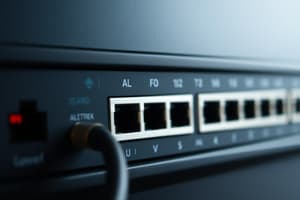Podcast
Questions and Answers
Which key is used by the sender to encrypt the messages for achieving confidentiality?
Which key is used by the sender to encrypt the messages for achieving confidentiality?
- Receiver's private key
- Sender's private key
- Receiver's public key (correct)
- Sender's public key
What is a digital signature used for?
What is a digital signature used for?
- Creating a hash output
- Encrypting messages
- Verifying the authenticity and integrity of a message (correct)
- Generating public keys
What is a hash function?
What is a hash function?
- An algorithm that generates public keys
- An algorithm that verifies digital signatures
- An algorithm that computes a fixed-size bit string value from an input message/file (correct)
- An algorithm that encrypts messages
Which key is used to decode a digital signature?
Which key is used to decode a digital signature?
What is the purpose of a Public Key Infrastructure (PKI)?
What is the purpose of a Public Key Infrastructure (PKI)?
What is a Certification Authority (CA) responsible for?
What is a Certification Authority (CA) responsible for?
What does a digital certificate bind together?
What does a digital certificate bind together?
What is the purpose of a firewall in network security?
What is the purpose of a firewall in network security?
What does AAA stand for in network security mechanisms?
What does AAA stand for in network security mechanisms?
What is the purpose of an Intrusion Detection System (IDS)?
What is the purpose of an Intrusion Detection System (IDS)?
Which of the following is NOT one of the elements of the CIA Triad?
Which of the following is NOT one of the elements of the CIA Triad?
What does the Access control policy specify?
What does the Access control policy specify?
What does the Privacy policy describe?
What does the Privacy policy describe?
What does the Acceptable use policy define?
What does the Acceptable use policy define?
What does the Auditing policy explain?
What does the Auditing policy explain?
What is the purpose of authentication?
What is the purpose of authentication?
What are the three types of authentication factors?
What are the three types of authentication factors?
What is the purpose of authorization?
What is the purpose of authorization?
What does access control refer to?
What does access control refer to?
What is the purpose of encryption?
What is the purpose of encryption?
Which of the following is NOT a security control mentioned in the text?
Which of the following is NOT a security control mentioned in the text?
What is the purpose of a network security policy?
What is the purpose of a network security policy?
Why is it important for a company to demonstrate that its information systems are secure?
Why is it important for a company to demonstrate that its information systems are secure?
What is the purpose of authentication/authorization/auditing (AAA)?
What is the purpose of authentication/authorization/auditing (AAA)?
What is the purpose of encryption?
What is the purpose of encryption?
What is the purpose of a virtual private network (VPN)?
What is the purpose of a virtual private network (VPN)?
What is the purpose of a firewall?
What is the purpose of a firewall?
What is the purpose of an Intrusion Detection system and Intrusion Prevention system (IDS/IPS)?
What is the purpose of an Intrusion Detection system and Intrusion Prevention system (IDS/IPS)?
Which of the following is NOT mentioned as a benefit of demonstrating information systems security?
Which of the following is NOT mentioned as a benefit of demonstrating information systems security?
What does a network security policy describe?
What does a network security policy describe?
Flashcards are hidden until you start studying
Study Notes
Encryption and Digital Signatures
- The sender uses a private key to encrypt messages for achieving confidentiality.
- A digital signature is used to ensure authenticity, integrity, and non-repudiation of a message.
Hash Function and Digital Signature
- A hash function is used to create a digital signature by creating a fixed-length string (digest) from a variable-length message.
- The sender's private key is used to decode a digital signature.
Public Key Infrastructure (PKI)
- A Public Key Infrastructure (PKI) is used to manage public-private key pairs, certificates, and CAs.
- The purpose of a PKI is to provide authentication, encryption, and digital signatures.
Certification Authority (CA)
- A Certification Authority (CA) is responsible for issuing, revoking, and managing digital certificates.
Digital Certificate
- A digital certificate binds together a public key with an entity's identity information.
Network Security
- A firewall is used to filter incoming and outgoing network traffic based on security rules.
- AAA in network security mechanisms stands for Authentication, Authorization, and Accounting.
Intrusion Detection System (IDS)
- The purpose of an Intrusion Detection System (IDS) is to detect and alert on potential security threats.
CIA Triad
- The CIA Triad consists of Confidentiality, Integrity, and Availability.
- Accountability is NOT one of the elements of the CIA Triad.
Security Policies
- An access control policy specifies the rules for accessing resources.
- A privacy policy describes how personal data is handled and protected.
- An acceptable use policy defines the rules for using company resources.
- An auditing policy explains the procedures for tracking and monitoring user activities.
Authentication and Authorization
- The purpose of authentication is to verify the identity of a user or device.
- The three types of authentication factors are Something You Know, Something You Have, and Something You Are.
- The purpose of authorization is to determine what resources a user can access.
- Access control refers to the process of granting or denying access to resources.
Encryption and Network Security
- The purpose of encryption is to protect data confidentiality and integrity.
- Network security controls include firewalls, IDS/IPS, and VPNs.
Purpose of Security Measures
- The purpose of demonstrating information systems security is to ensure the confidentiality, integrity, and availability of data.
- The purpose of AAA is to manage access, authentication, and auditing.
- The purpose of a VPN is to provide secure communication over the internet.
- The purpose of a firewall is to filter incoming and outgoing network traffic.
- The purpose of an IDS/IPS is to detect and prevent security threats.
- A network security policy describes the rules and procedures for securing a network.
Studying That Suits You
Use AI to generate personalized quizzes and flashcards to suit your learning preferences.





